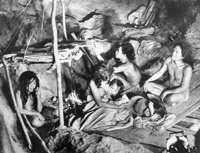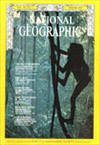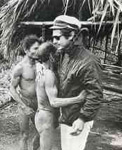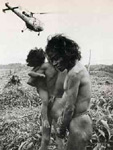Who are the Tasaday? Depending on whom you ask, you'll hear very different answers to this question. You'll either hear that they're a group of leaf-wearing, stone-age-tool-using cave dwellers who, when they were discovered in 1971 living in a rain forest on the Philippine island of Mindanao, believed they were the only people in the world. Or you'll hear that they're a complete fraud... poor farmers who were cynically coerced into posing as a stone-age tribe by powerful politicians. What's the truth? To that there is no simple answer.
The Tasaday As A Real Tribe

The Tasaday in their caves.
Let's start with the version of the Tasaday story that the world first heard — the one in which they're a real stone-age tribe.
In this version of events, the Tasaday had been living in their caves in the rain forest for over one thousand years before their isolation ended when a hunter from a neighboring tribe stumbled upon them while laying his traps. This hunter eventually mentioned their existence to Manuel Elizalde, Jr., the adviser to Ferdinand Marcos on Filipino national minorities, and Elizalde, intrigued, choppered out into the jungle to meet them. (The exact date of this meeting has been reported as either June 4 or 7, 1971). Thus, contact was made.
Soon anthropologists, reporters, and even celebrity visitors such as Charles Lindbergh and Gina Lollobrigida, were flying out to the Tasaday's jungle home. Almost overnight the tribe went from being unknown to being internationally famous. Pictures of them posing in their caves appeared in magazines throughout the world. Documentaries about them aired on TV. A Tasaday child climbing some vines graced the cover of
National Geographic. And AP photographer John Nance wrote a bestselling book about them titled
The Gentle Tasaday.
 National Geographic
National Geographic cover featuring the Tasaday.
What most captivated the world about the Tasaday was their peacefulness. It was said they knew no words for enemy or conflict. They seemed to be an uncorrupted version of Man, living in a rain-forest Garden of Eden. Their gentleness was especially striking in 1971 when images of violence and horror were coming daily out of Vietnam.
But there was trouble lurking in the background for the Tasaday, trouble that stemmed from their close association with Manuel Elizalde, Jr. From the moment of their discovery, Elizalde had appointed himself their protector and tightly controlled access to them, but Elizalde was a controversial figure. He was a wealthy playboy with numerous business interests and lofty political ambitions (and thus many enemies), who, despite his jet-setting ways, liked to promote himself as a champion of tribal minorities. The tight rein he kept on access to the Tasaday angered many, and when he persuaded Marcos to declare the Tasaday's rain forest a protected reserve, many were suspicious that sinister motives underlay his interest in the tribe. Specifically, his enemies suspected that he was using the Tasaday both to engineer a massive land-grab and to further his political ambitions.
This was the state of affairs when Marcos declared martial law in 1972, causing access to the Tasaday to become much more restricted. And when Marcos issued a decree in 1976 "protecting the Tasaday and other unexplored cultural communities from unauthorized entry," access to the Tasaday ended altogether. No one was allowed to visit them, and so, from the point of view of the outside world, the Tasaday abruptly vanished from sight.
The Tasaday As A Fake Tribe

Manuel Elizalde (right) embraces one of the Tasaday (July, 1971)
In 1986 the Marcos government was overthrown, and Oswald Iten, a Swiss journalist, accompanied and guided by a Filipino reporter named Joey Lozano, seized this opportunity to trek out into the jungle to find out what had become of the Tasaday. What Iten found shocked him, and soon became the basis for the second version of the Tasaday story, the one in which they're an outrageous hoax.
Iten found the Tasaday's caves empty and the tribe members living in huts nearby, dressed in jeans and t-shirts, living a simple, but certainly not primitive, lifestyle. Upon questioning them (using Lozano as a translator), two of the Tasaday admitted to Iten that they weren't really a stone-age tribe and never had been. They claimed that Elizalde had pressured them into posing as one.
"We didnt live in caves, only near them, until we met Elizalde," they said.
"Elizalde forced us to live in the caves so that we'd be better cavemen. Before he came, we lived in huts on the other side of the mountain and we farmed. We took off our clothes because Elizalde told us to do so and promised if we looked poor that we would get assistance. He gave us money to pose as Tasaday and promised us security from counter-insurgency and tribal fighting."
Iten's discovery sent shockwaves around the world — a fake stone-age tribe managed to surprise even the most jaded newspaper readers — and soon reporters were once again making the journey out into the Filipino rain forest to visit the Tasaday.
Adding an element of sad comedy to the unfolding story, a group of German journalists who arrived within days of Iten's departure found the Tasaday back at their caves dressed in leaves. But upon closer inspection the Germans noticed cloth garments peeking out from beneath the Tasaday's leaves, as if the Tasaday, caught unaware by Iten, had hastily decided to resume the act of being a stone-age tribe, but weren't quite sophisticated enough to pull it off without outside coaching and so had simply pulled on leaves over their clothes.
Researchers, searching for evidence of a hoax, now realized there were many unanswered questions about the Tasaday. For instance, was it really believable that the Tasaday had been isolated for a thousand years given that they lived only a few miles away from a nearby village? Why did the Tasaday seem to be resistant to modern diseases? (Their isolation should have left them with little resistance.) Why had Elizalde so tightly controlled access to the tribe? And why did many of their instruments and utensils appear to have been cut with steel knives if they lacked all knowledge of steel?
Faced with questions like these, and armed with confessions from the Tasaday themselves, the media decided the matter was settled. The Tasaday were dismissed as a hoax, an outrageous publicity stunt dreamed up by Marcos and his cronies to put a gentle face on the country's totalitarian government. This judgement was expressed in documentaries such as
Scandal, the Lost Tribe and
The Tribe That Never Was. And so the tribe became the laughing stock of the world. Iten dubbed them the Philippine equivalent of a Swiss yodeling society.
The Revenge of the Tasaday
However, not everyone thought the matter was settled. The Tasaday still had friends (Elizalde, in particular) who believed in them, and these friends now went to work to repair the tribe's battered reputation.
Despite the overthrow of Marcos, Elizalde continued to wield enough influence in the Philippines to mount a vigorous pro-Tasaday campaign. He led the defense of the Tasaday when the Philippine Congress investigated the hoax claims in 1987 (the Congress eventually decided the issue was best left to scientists, not politicians, to decide), and in 1988 he flew members of the Tasaday to Manila so that they could file a lawsuit against the Philippine professors who were calling them a hoax. This made the Tasaday the first stone-age tribe to ever sue for libel! These efforts paid off when, also in 1988, Philippine president Corazon Aquino declared that the Tasaday were a "legitimate Stone Age tribe." (It's rumored that one of Aquino's speechwriters was a personal friend of Elizalde.)
Elizalde could exert political and legal pressure to defend the Tasaday, but these tactics had little effect on scientific opinion. But increasing numbers of scientists were won over to the pro-Tasaday side by the fieldwork of researchers such as Lawrence Reid of the University of Hawaii who lived with the Tasaday for extended periods throughout the 1990s.
Reid studied the Tasaday language and concluded that it was not fake or recently invented. He identified their language as a dialect of Cotabato Manobo (which was not the language spoken by the nearby farming community from which, according to the hoax theory, they had been recruited). However, Reid also concluded that the Tasaday had not been isolated for a thousand years. He speculated that they had splintered off from the Cotabato Manobo community approximately 150 to 200 years ago, perhaps fleeing into the jungle to escape an outbreak of disease.
Reid's linguistic evidence was compelling, but there was one damning piece of evidence that supporters of the Tasaday still had to account for: the Tasaday's own confession that they were a hoax. How to explain this away? This puzzle was answered when two members of the Tasaday admitted that, yes, they had made such a confession, but also insisted that they had been bribed by a translator to make the confession. And why would the translator have done such a thing? Friends of the Tasaday credited this to the anti-Marcos sentiment that ran high in the Philippines in 1986. There were many who were eager to tear down anything associated with Marcos, and since the Tasaday had been considered a showpiece of his regime, a means by which he projected an idyllic view of the Philippines to the outside world, they became a target of choice for Marcos's detractors.
This became the version of the Tasaday story promoted by friends of the Tasaday. The Tasaday, they said, were a real tribe, but they had been the victims of the downfall of Marcos. In other words, the claim that they were a hoax was itself the real hoax! Enemies of Marcos had relentlessly smeared the Tasaday as a way to get back at Marcos. These enemies included loggers who were eager to gain access to the Tasaday rainforest, a desire that had been stymied when Marcos declared it a protected reserve. If the Tasaday were deemed a hoax, the tribe's rights to the reserve would vanish, and the loggers could move in. So, as the friends of the Tasaday explained, there was a powerful financial incentive to make the world believe the Tasaday were a fake stone-age tribe.
Making Sense of the Tasaday

One of the Tasaday looks away as a helicopter carrying western journalists takes off
So what's a person to conclude? Are the Tasaday a hoax, or is the idea that they're a hoax itself a hoax? Which version of events is correct? The answer is that the truth probably lies somewhere in the middle of all these competing claims.
As Lawrence Reid concluded, the Tasaday really had been living on their own in the rain forest, but apparently only for about 150 years. Not one thousand years. In addition, they seemed to have made contact with neighboring tribes sometime in the 1950s, and through this contact had acquired steel tools and learned some agricultural skills. So when the wider world discovered them in 1971 they were definitely not as isolated, nor as 'stone-age,' as was first claimed. However, they really were living a very primitive existence.
Elizalde appears guilty of having encouraged the Tasaday to try to look more primitive for the benefit of the cameras. He asked them to wear leaves and hide any steel tools. In this sense, he tweaked the truth, as did the Marcos government which shamelessly promoted the Tasaday as a symbol of the Philippines.
However, the Tasaday themselves appear to have willingly played the role asked of them. After all, they liked the attention and hoped that Elizalde would provide them with aid. So why not do what their new friends wanted them to do? This eagerness to play the part of a stone-age tribe could assume bizarre forms, such as when they donned leaves over their clothes for the benefit of the German reporters in 1986. (The fact that they had been wearing jeans and t-shirts when Iten found them is easily explained by the fifteen years of acculturation they had experienced since 1971.) There was also a surreal moment in 1988 when members of the Tasaday agreed to participate in a cultural festival at Lake Sebu, during which they posed in imitation caves for the benefit of onlookers, like exhibits in a zoo.
Then there's the media, which repeatedly misrepresented the Tasaday. In 1971 it hyped them as a peacenik, utopian, stone-age tribe, and in 1986 it reversed course and branded them an absolute hoax. It could only see the Tasaday in sensationalistic black-and-white terms, as either throwbacks to the stone-age or a fraud, never in shades of grey.
Finally, it does appear that enemies of Marcos and loggers did join forces in the late '80s to discredit the Tasaday, going so far as to bribe members of the group to provide false confessions. So there is some truth to the 'hoax itself is a hoax' claim.
In other words, just about everyone involved in the story of the Tasaday was bending the truth for their own purposes. As a result, as Robin Hemley has written, "Nearly every event surrounding the Tasaday is ambiguous and open to interpretation." A very postmodern condition for a stone-age tribe.
To sum up: The Tasaday weren't a true stone-age tribe. But nor were they farmers coerced into playing a stone-age tribe. Instead, they were very poor people living close to Nature in the Philippine jungle who became swept up in and manipulated by global events beyond their control. This version of events isn't as compelling as the versions that made headlines in 1971 and 1986, but it is a good illustration of how the truth is often far messier and more complicated than it appears at first glance.
Links and References





Comments
when we were young our father use to tell us story about the tasaday people, he was a former phil constabulary retired, who was assigned as security of PANAMIN,we grow up in tboli south cotabato, as the years go by the story about the tasadays were gone and no longer told, but my father use to remember everything up to this date living in tboli,
thanks for this site, i remember what my father told us . . . . .
But Margaret probably didn't foresee that so many people would begin to travel the globe and check out her claims.
Margie was really just another leftist hoaxer hore.